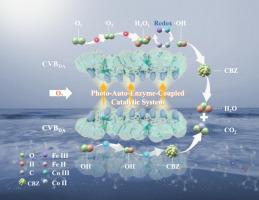当前位置:
X-MOL 学术
›
Chem. Eng. J.
›
论文详情
Our official English website, www.x-mol.net, welcomes your feedback! (Note: you will need to create a separate account there.)
A twin S-scheme CoFe2O4/VCNDA/BiVO4 nanozyme for photo-auto-enzyme-coupled catalytic degradation of carbamazepine
Chemical Engineering Journal ( IF 13.3 ) Pub Date : 2024-06-29 , DOI: 10.1016/j.cej.2024.153606 Chujun Feng , Qinyi Gu , Jian Rong , Xudong Zheng , Yuzhe Zhang , Qian Liang , Zhongyu Li , Song Xu
Chemical Engineering Journal ( IF 13.3 ) Pub Date : 2024-06-29 , DOI: 10.1016/j.cej.2024.153606 Chujun Feng , Qinyi Gu , Jian Rong , Xudong Zheng , Yuzhe Zhang , Qian Liang , Zhongyu Li , Song Xu

|
The photo-enzyme-coupled catalytic (PECC) system combines the high selectivity of enzymatic reaction with the unique activity of photocatalytic reaction, which shows great application potential in the field of organic pollutant degradation. However, the traditional PECC system usually requires additional to enzyme substrates to achieve the enzymatic reaction, which increases the risk of environmental pollution. Herein, the twin S-scheme CoFeO/vesicular g-CN-FeCo/BiVO (CVB) nanozyme with good horseradish peroxidase (HRP) activity was prepared and used to construct the unique photo-auto-enzyme-coupled catalytic (PAECC) system. The twin S-scheme mechanism was confirmed by the XPS and UPS. In this heterojunction, the strong redox ability of CVB nanozyme can be effectively retained for the efficient degradation of pollutants and catalysis of oxygen reduction reactions. And the abundant HO provided by the oxygen reduction reaction lays the foundation for excellent HRP activity and effectively increases the amount of active group to improve the oxidation performance of CVB nanozyme. With 1 mg/L carbamazepine as the target contaminant, the degradation efficiency of CVB nanozyme can reach 90.9 % in the PAECC system. This study provides a new idea for the design of twin S-scheme nanozyme to improve the catalytic performance of photo-enzyme-coupled catalytic system.
中文翻译:

双S型CoFe2O4/VCNDA/BiVO4纳米酶用于光自酶耦合催化降解卡马西平
光酶耦合催化(PECC)系统结合了酶反应的高选择性和光催化反应的独特活性,在有机污染物降解领域显示出巨大的应用潜力。然而,传统的PECC系统通常需要额外的酶底物来实现酶促反应,这增加了环境污染的风险。在此,制备了具有良好辣根过氧化物酶(HRP)活性的孪生S型CoFeO/囊泡g-CN-FeCo/BiVO(CVB)纳米酶,并用于构建独特的光自酶偶联催化(PAECC)系统。双S方案机制得到了XPS和UPS的证实。在这种异质结中,CVB纳米酶强大的氧化还原能力可以有效保留,用于污染物的高效降解和氧还原反应的催化。而氧还原反应提供的丰富的H2O为优异的HRP活性奠定了基础,有效增加了活性基团的数量,提高了CVB纳米酶的氧化性能。以1 mg/L卡马西平为目标污染物,CVB纳米酶在PAECC系统中的降解效率可达90.9%。该研究为双S型纳米酶的设计、提高光酶偶联催化体系的催化性能提供了新的思路。
更新日期:2024-06-29
中文翻译:

双S型CoFe2O4/VCNDA/BiVO4纳米酶用于光自酶耦合催化降解卡马西平
光酶耦合催化(PECC)系统结合了酶反应的高选择性和光催化反应的独特活性,在有机污染物降解领域显示出巨大的应用潜力。然而,传统的PECC系统通常需要额外的酶底物来实现酶促反应,这增加了环境污染的风险。在此,制备了具有良好辣根过氧化物酶(HRP)活性的孪生S型CoFeO/囊泡g-CN-FeCo/BiVO(CVB)纳米酶,并用于构建独特的光自酶偶联催化(PAECC)系统。双S方案机制得到了XPS和UPS的证实。在这种异质结中,CVB纳米酶强大的氧化还原能力可以有效保留,用于污染物的高效降解和氧还原反应的催化。而氧还原反应提供的丰富的H2O为优异的HRP活性奠定了基础,有效增加了活性基团的数量,提高了CVB纳米酶的氧化性能。以1 mg/L卡马西平为目标污染物,CVB纳米酶在PAECC系统中的降解效率可达90.9%。该研究为双S型纳米酶的设计、提高光酶偶联催化体系的催化性能提供了新的思路。






































 京公网安备 11010802027423号
京公网安备 11010802027423号